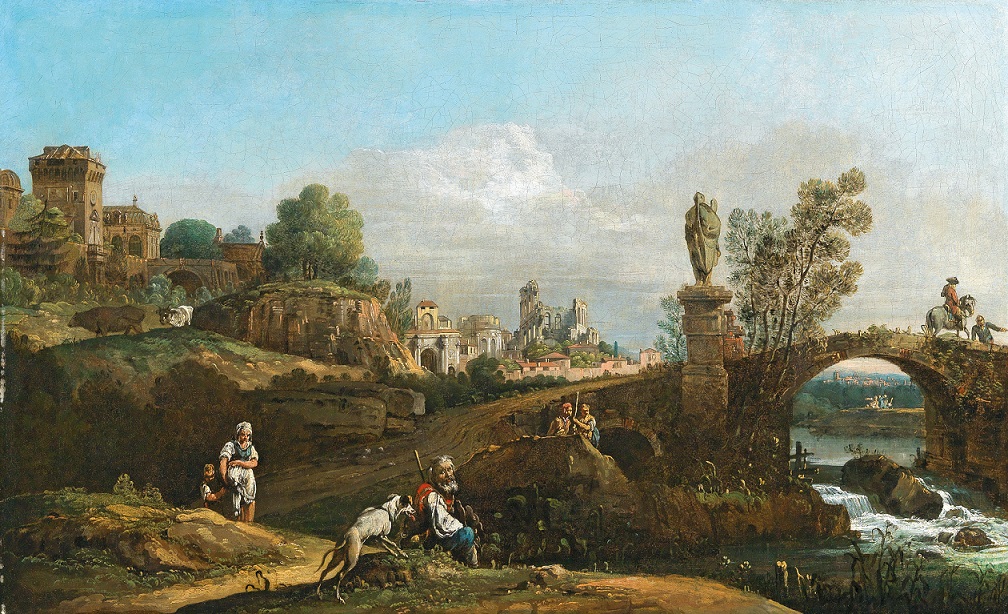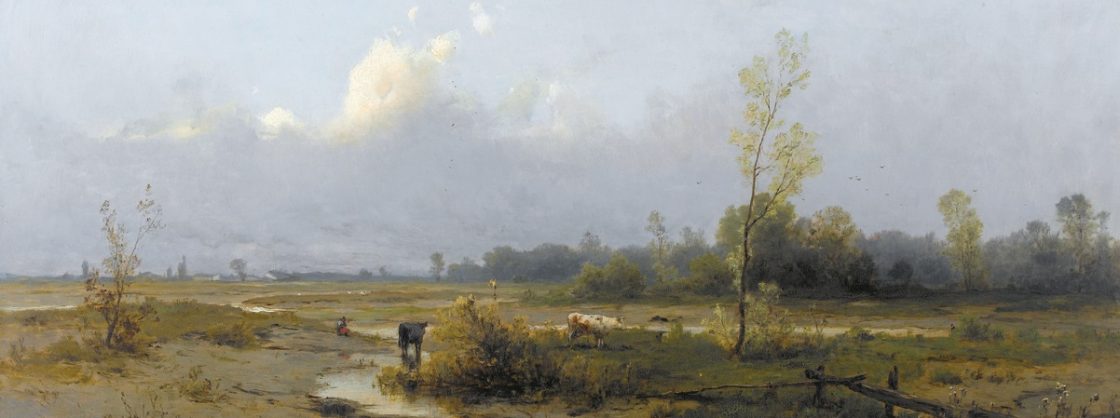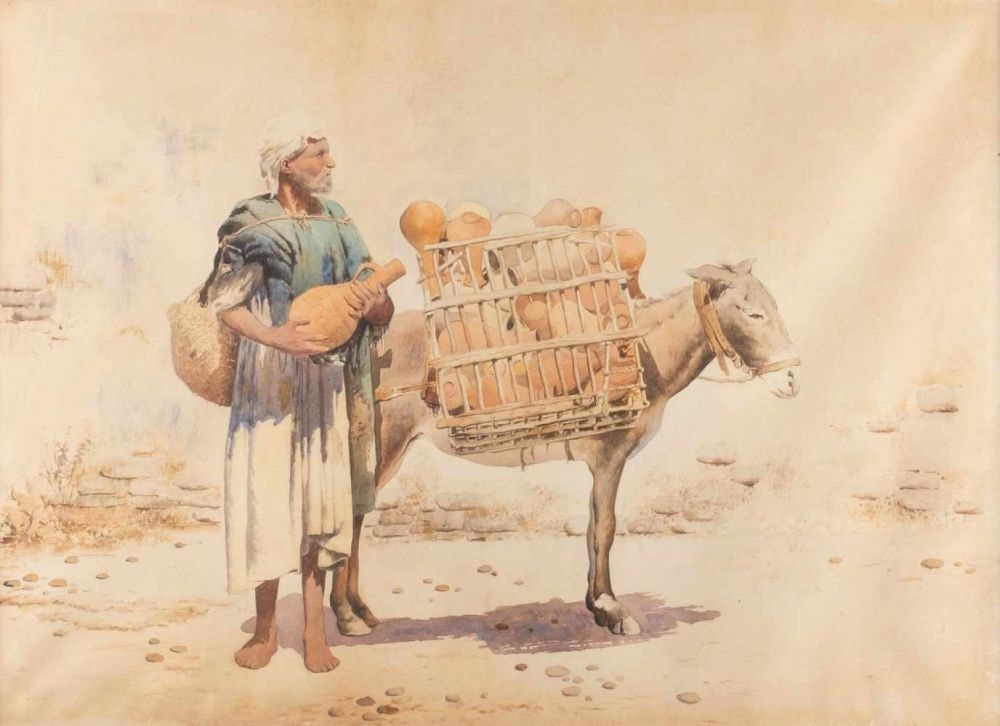
Malarz mający istotne miejsce w polskiej historii. Ten obraz Bellotta powstał sporo wcześniej przed przyjazdem do Warszawy ale warto go zachować i poczytać o jego proweniencji, wystawach, publikacjach i ogólnych informacjach o malarzu i obiekcie malowania. Dużo ciekawego do czytania poniżej z katalogu aukcyjnego. A propos proweniencji to chciałoby się taką skrupulatną widzieć w przypadku każdej innej sprzedawanej pracy. Inna uwaga to, moim zdaniem, absurdalnie niskie widełki wyceny za ten obraz. Gdyby ta praca została sprzedana za jedyne 100,000 euro to potrzeba sprzedać 4-5 podobnych prac tego artysty by zrównoważyc cenę jednego ‘koła’ Fangora. Kompletny absurd z cenami na ‘koła’.
Lot 28. Bernardo Bellotto (Venice 1721–1780 Warsaw). Landscape capriccio with classical and medieval motifs and some buildings from Dresden, oil on canvas, 49.5 x 80.5 cm, framed. Estimate 100,000 – 150,000 euro. Dorotheum. 10/23/19
Provenance: Collection of Sir William James Farrer (1822–1911), Sandhurst Lodge, Berkshire; his sale, Christie, Manson & Woods, London, 23 March 1912, lot 36; bought by Lippmann; Collection of Robert Zahn (1861–1914), Plauen; his sale, Hugo Helbig, Munich, 21 November 1917, lot 5; bought by A. S. Drey, Munich; Collection of Camillo Castiglioni (1897–1957), Vienna;
his sale, F. Muller & Cie., Amsterdam, 17 November 1925, lot 29; with Thomas Agnew & Sons, London, 1926; Collection Sigmund Sachsel (1873–1928), Vienna; his sale, Dorotheum, Vienna, 5 June 1931, lot 1; with Galerie Sanct Lucas, Vienna, 1965; Private collection, Austria
Exhibited:
Vienna, Belvedere Museum, Bernardo Bellotto genannt Canaletto, 29 April – 25 July 1965, no. 44;
Houston, Museum of Fine Arts, Bernardo Bellotto and the Capitals of Europe, 29 July – 21 October 2001, no. 83
Literature:
I. Haumann, Das oberitalienische Landschaftsbild des Settecento, Strasbourg 1927, p. 79;
H. A. Fritzsche, Bernardo Belotto genannt Canaletto, Magdeburg 1936, pp. 65, 99–100, p. 124, VG 180, p. 125, mentioned under VG 189;
S. Kozakiewicz, Bernardo Bellotto genannt Canaletto: Ausstellung unter der Leitung von: Staatliche Kunstsammlungen Dresden, Nationalmuseum Warschau, Kunsthistorische Museum Wien, exhibition catalogue, Vienna 1965, p. 59, no. 44, ill. no. 91;
S. Kozakiewicz, Bernardo Bellotto, Milan 1972, vol. I, p. 138, vol. II, pp. 283-284, no. 358, ill. p. 285;
E. Camesasca, L’opera completa del Bellotto, Milan 1974, no. 199;
A. Rizzi, Bernardo Bellotto. Dresda Vienna Monaco (1747-1766), Venice 1996, p. 161, no. 141;
E. P. Bowron, in: E. P. Bowron (ed.), Bernardo Bellotto and the Capitals of Europe, exhibition catalogue, New Haven/London 2001, p. 242, no. 83, ill. p. 243
The present painting is an important example of Bernardo Bellotto’s work during his second Dresden period, around 1765. At this time the painter concentrated on creating idealised views and capriccio paintings, a genre he had experimented with during his youth in Italy. These imaginary landscapes include real elements, as is the case with the present painting which represents an idyllic hilly landscape. In the background there are buildings inspired by the antique and the middle-ages, as well as recognisable monuments from the city of Dresden. On the left the still extant Zwinger Palace can be recognised, while the ruins at the centre are a probable reference to the Prussian bombardment of Dresden in 1760, during which time Bellotto also saw his home destroyed.
In the foreground a path cuts through the scene diagonally, leading to a bridge on the right. Under the arch of the bridge, another city is visible in the distance. The statue on a pedestal to the left hand side of the bridge is reminiscent of the same subject depicted by Bellotto in his earlier painting of the Karlskirche in Vienna (see Kozakiewicz 1972, vol. II, p. 200, no. 257). In the present painting the scene is animated by a number of country-folk, including a man in the foreground seated with his dog; this bearded figure is shown in different poses in other compositions by the artist, including the Imaginary view with Bellotto’s self-portrait in the National Museum, Warsaw.
The figures in the present painting are typical of Bellotto’s production during his second Dresden period, when the artist modelled the humble figures of his paintings directly from reality, almost with the intent of portraiture. The representation of the poor and marginal classes of society was rare in eighteenth century Italian painting, and the dignity with which Bellotto imbues them is reminiscent of Giacomo Ceruti’s paintings of mendicants and farming-folk. The style of the painting is typical of Bellotto during these years, it is characterised by bold fluid brushstrokes and the deployment of cool colours in compositions poised between the real and the imaginary, capturing a melancholy tone, which possibly reflects the suffering the artist himself experienced as a result of the war in the German city.
The present painting is known in another version that differs in some details: probably made by Bellotto in collaboration with his son Lorenzo (see Kozakiewicz 1972, vol. II, p. 284, no. 358a).
Bernardo Bellotto trained in Venice it is believed, under his uncle, Canaletto and from the outset he focused on the depiction of views of the city. His pictorial language attained an independence thanks to the journeys he took during the 1740s through the Veneto, Lombardy, Tuscany and to Rome. He travelled to Dresden for the first time in 1747 where he became court painter to Frederick Augustus II, Elector of Saxony. Here, he dedicated himself to the depiction of views of the city which was being remodelled during this period into one of the most important cultural centres of Europe. At the close of the next decade, he moved to Vienna, and then to Munich, thereafter returning to Dresden in 1761. Bellotto spent the final years of his career in Warsaw where he was engaged in the decoration of the royal palaces and he continued to produce view paintings for which he was celebrated throughout Europe.




